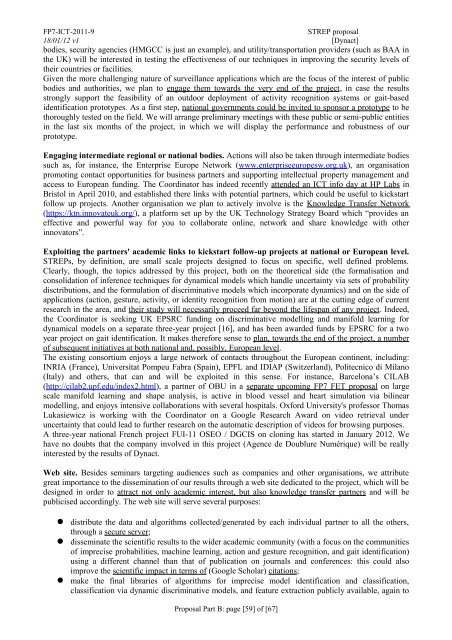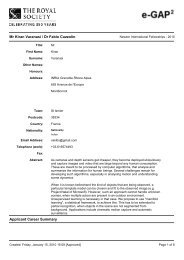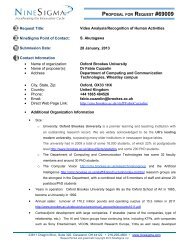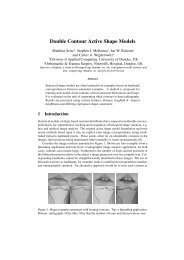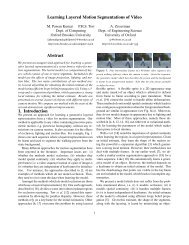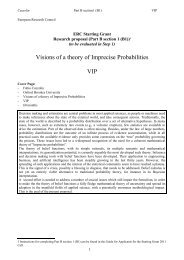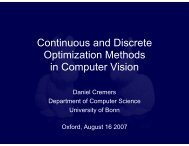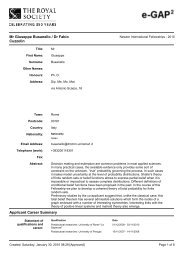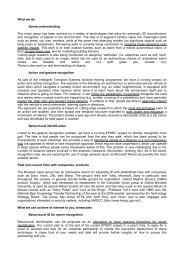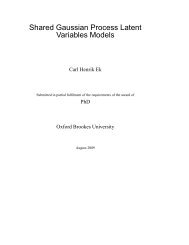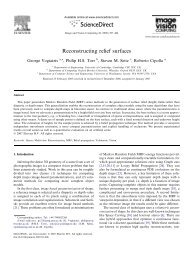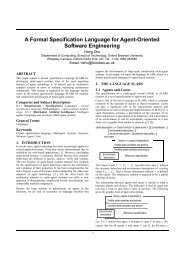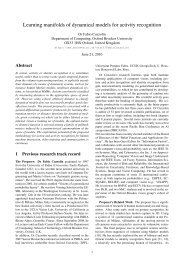Project Proposal (PDF) - Oxford Brookes University
Project Proposal (PDF) - Oxford Brookes University
Project Proposal (PDF) - Oxford Brookes University
You also want an ePaper? Increase the reach of your titles
YUMPU automatically turns print PDFs into web optimized ePapers that Google loves.
FP7-ICT-2011-9 STREP proposal<br />
18/01/12 v1 [Dynact]<br />
bodies, security agencies (HMGCC is just an example), and utility/transportation providers (such as BAA in<br />
the UK) will be interested in testing the effectiveness of our techniques in improving the security levels of<br />
their countries or facilities.<br />
Given the more challenging nature of surveillance applications which are the focus of the interest of public<br />
bodies and authorities, we plan to engage them towards the very end of the project, in case the results<br />
strongly support the feasibility of an outdoor deployment of activity recognition systems or gait-based<br />
identification prototypes. As a first step, national governments could be invited to sponsor a prototype to be<br />
thoroughly tested on the field. We will arrange preliminary meetings with these public or semi-public entities<br />
in the last six months of the project, in which we will display the performance and robustness of our<br />
prototype.<br />
Engaging intermediate regional or national bodies. Actions will also be taken through intermediate bodies<br />
such as, for instance, the Enterprise Europe Network (www.enterpriseeuropesw.org.uk), an organisation<br />
promoting contact opportunities for business partners and supporting intellectual property management and<br />
access to European funding. The Coordinator has indeed recently attended an ICT info day at HP Labs in<br />
Bristol in April 2010, and established there links with potential partners, which could be useful to kickstart<br />
follow up projects. Another organisation we plan to actively involve is the Knowledge Transfer Network<br />
(https://ktn.innovateuk.org/), a platform set up by the UK Technology Strategy Board which “provides an<br />
effective and powerful way for you to collaborate online, network and share knowledge with other<br />
innovators”.<br />
Exploiting the partners' academic links to kickstart follow-up projects at national or European level.<br />
STREPs, by definition, are small scale projects designed to focus on specific, well defined problems.<br />
Clearly, though, the topics addressed by this project, both on the theoretical side (the formalisation and<br />
consolidation of inference techniques for dynamical models which handle uncertainty via sets of probability<br />
disctributions, and the formulation of discriminative models which incorporate dynamics) and on the side of<br />
applications (action, gesture, activity, or identity recognition from motion) are at the cutting edge of current<br />
research in the area, and their study will necessarily proceed far beyond the lifespan of any project. Indeed,<br />
the Coordinator is seeking UK EPSRC funding on discriminative modelling and manifold learning for<br />
dynamical models on a separate three-year project [16], and has been awarded funds by EPSRC for a two<br />
year project on gait identification. It makes therefore sense to plan, towards the end of the project, a number<br />
of subsequent initiatives at both national and, possibly, European level.<br />
The existing consortium enjoys a large network of contacts throughout the European continent, including:<br />
INRIA (France), Universitat Pompeu Fabra (Spain), EPFL and IDIAP (Switzerland), Politecnico di Milano<br />
(Italy) and others, that can and will be exploited in this sense. For instance, Barcelona’s CILAB<br />
(http://cilab2.upf.edu/index2.html), a partner of OBU in a separate upcoming FP7 FET proposal on large<br />
scale manifold learning and shape analysis, is active in blood vessel and heart simulation via bilinear<br />
modelling, and enjoys intensive collaborations with several hospitals. <strong>Oxford</strong> <strong>University</strong>'s professor Thomas<br />
Lukasiewicz is working with the Coordinator on a Google Research Award on video retrieval under<br />
uncertainty that could lead to further research on the automatic description of videos for browsing purposes.<br />
A three-year national French project FUI-11 OSEO / DGCIS on cloning has started in January 2012. We<br />
have no doubts that the company involved in this project (Agence de Doublure Numérique) will be really<br />
interested by the results of Dynact.<br />
Web site. Besides seminars targeting audiences such as companies and other organisations, we attribute<br />
great importance to the dissemination of our results through a web site dedicated to the project, which will be<br />
designed in order to attract not only academic interest, but also knowledge transfer partners and will be<br />
publicised accordingly. The web site will serve several purposes:<br />
distribute the data and algorithms collected/generated by each individual partner to all the others,<br />
through a secure server;<br />
disseminate the scientific results to the wider academic community (with a focus on the communities<br />
of imprecise probabilities, machine learning, action and gesture recognition, and gait identification)<br />
using a different channel than that of publication on journals and conferences: this could also<br />
improve the scientific impact in terms of (Google Scholar) citations;<br />
make the final libraries of algorithms for imprecise model identification and classification,<br />
classification via dynamic discriminative models, and feature extraction publicly available, again to<br />
<strong>Proposal</strong> Part B: page [59] of [67]


